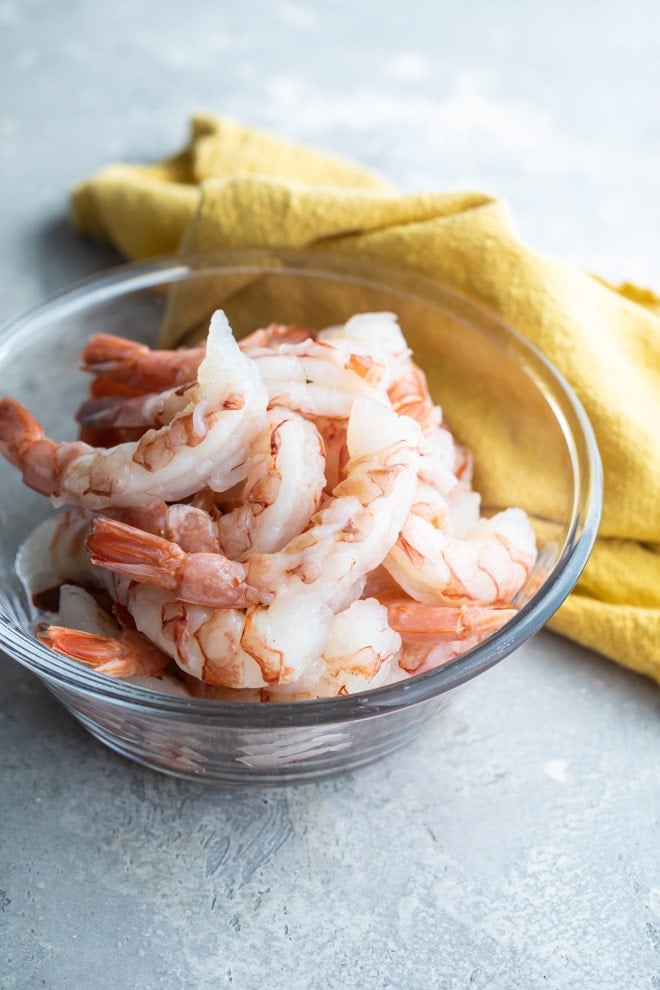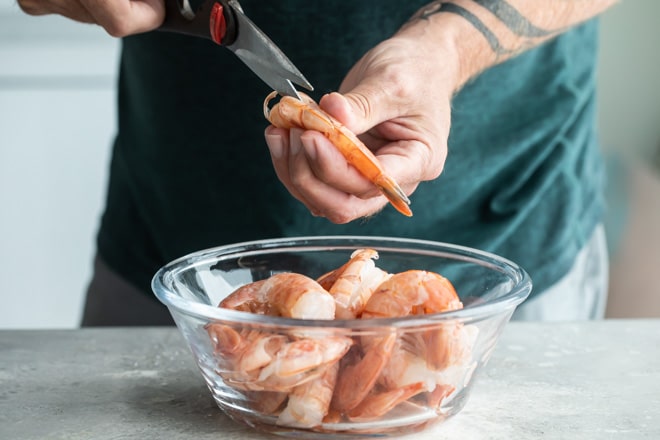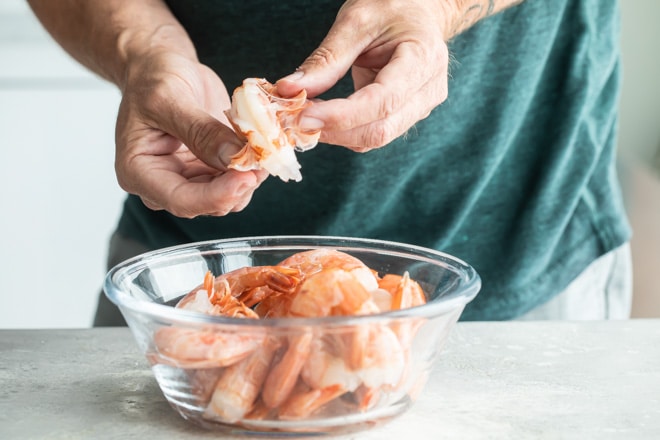How To Clean Shrimp Without Removing Shell
This quick and easy how-to for cleaning and deveining shrimp is used by caterers and culinary professionals for a very good reason. It always results in gorgeous, luscious shrimp for all your best recipes.

Why do it? Cleaning and shelling prawns and shrimp at home is a great alternative to buying bags of EZ-peel or pre-peeled shrimp. Chances are you'll have more sizes to choose from and better quality shrimp for the price. In my book, that's one of the best reasons to do it yourself.
Is cleaning shrimp really necessary?
Technically, no. The little black line on the bottom of the shrimp, also called a "vein," is just a digestive tract. Depending on what the shrimp ate before it was caught, it could be darker than the rest of the meat. It could have some sand in it, or algae. But, is shrimp poop safe to eat?
While some people consider it unsightly or are turned off by it, it really isn't harmful to eat. It just looks better without it.
Peeling shrimp before eating them, on the other hand, makes for a better experience, texture-wise. But even that isn't entirely necessary. I know lots of folks who love their spiced, in-the-peel boiled shrimp sold in seafood markets on the East coast.
When do you clean shrimp?
You can clean shrimp when they're raw or previously cooked. Here are some guidelines:
- Clean before cooking: Pasta dishes, stir-fries, and Shrimp Fajitas.
- Clean after cooking: Shrimp salad, Seafood Pasta Salad. You can poach the shrimp in their shells for more flavor, and peel and clean after chilling the shrimp (since you serve it cold).
- Leave the tail on: It looks nice for Shrimp Scampi and Shrimp Skewers, or any time you are using the tail as a handle such as Coconut Shrimp or shrimp cocktail.
- Eat the shells: Some people do this. I tried it in culinary school. It was fine. My jaw got tired.
Step-by-step instructions:
This method works with any size shrimp, raw or cooked, peel-on or peel-off. Cleaning and peeling frozen shrimp? Read how to thaw shrimp below before you begin.
All you need is a pair of sturdy kitchen shears or a sharp paring knife. Work one shrimp at a time.
- Using the knife (or shears) make a shallow slice (or snip) right through the shell on the shrimp's back, from its head to its tail. (I start at the fattest part of the shrimp and cut towards the tail.)

- Then carefully pick out the black or green vein that runs along the back and discard it.

- If you want to devein a shrimp with the shell on, that's all there is to it—you're done. On to the next shrimp! Otherwise, remove the shrimp shell using the instructions below.
Peeling and shelling shrimp:
You can peel shrimp before or after cooking—it's up to you and the recipe.
- To take the shell off a shrimp, start by pinching off the tail, then the rest of the shell should peel off fairly easily.

- To leave the tail on shrimp, break off the shell at the base of the tail, and remove the shell and legs, if they're attached, leaving the tail in tact.
Figuring out shrimp sizes:
On the boat and at the factory, shrimp are sorted by size and given a number. This number lets you know about how many shrimp come in a pound.
For example, the numbers 16/20 tells you that there are anywhere from 16 to 20 shrimp per pound.
Other times, you may see a letter U before a number, like U10. That means that there are approximately 10 shrimp (or under) per pound. For example…
- Extra colossal shrimp= U10 shrimp= under 10 shrimp per pound
- Colossal shrimp= U15 shrimp= under 15 shrimp per pound
- Extra jumbo shrimp= 16/20 shrimp= 16 to 20 shrimp per pound
- Extra large shrimp= 26/30 shrimp= 26 to 30 shrimp per pound
You may have guessed this already, but the higher the number, the smaller the shrimp. The lower the number, the larger (and pricier) the shrimp.
Don't be afraid to go small. Tiny shrimp are delicious choices for shrimp salad, stir-fry, or a big batch of fried rice. Save the biggest shrimp for making big impressions. (Think super fancy shrimp cocktail or shrimp skewers.)

Recipe tips:
- Fresh or frozen shrimp? Unless you live right on the coast, the best choice is frozen shrimp. I always buy frozen shrimp, no matter what. Really! Here's why.That's because almost all shrimp that comes to us has been previously frozen, usually as soon as it's caught on the boat. When you thaw shrimp at home, you're getting the absolute freshest shrimp possible. When you buy "fresh" shrimp at the grocery store, someone else has thawed it, but you don't know when. Maybe yesterday, maybe last week. Better to be safe than sorry, because fresh shrimp tastes so much better than, well, not fresh shrimp.
- What to look for when buying fresh shrimp. Use your senses when shopping for shrimp. Good quality, freshest-of-the-fresh shrimp should smell briny and even sweet, like the ocean. Go somewhere else if the shrimp smell like ammonia, are slimy, and have black spots on the shells, which is a sign of age.
- Wild or farmed shrimp? That depends on your and your grocery budget! Wild-caught shrimp have a stronger flavor, but can cost a lot more.I usually choose farm-raised shrimp from a sustainable, responsible grower. If you're in doubt, read the packaging carefully—shrimp farmers are proud of their sustainability efforts and will advertise it on the label—and look up the latest shrimp news on Seafood Watch.
- Thaw in the refrigerator: Let the shrimp thaw overnight in the fridge, (place the bag on a tray or in a bowl in case the bag has a tiny hole– and yes, I learned this the hard way.)
- Thaw in the sink: For quicker thawing, open the bag and put them in a bowl of cold (not warm) water. Then turn on the faucet and let a thin trickle of cold water run into the bowl, letting the excess water overflow out of the bowl and down the sink drain. Depending on the amount you are thawing, the shrimp should thaw in a few minutes.
- Shrimp stock: Save those shells and make a delicious batch of homemade shrimp stock.
How to Clean Shrimp
This quick and easy how-to for cleaning and deveining shrimp is used by caterers and culinary professionals for a very good reason. It always results in gorgeous, luscious shrimp for all your best recipes.
Prep Time 10 mins
Total Time 10 mins
Servings 4 servings
Course Appetizer, Main Course
Cuisine American
Calories 113
- 1 pound shrimp or more
-
If shrimp are still in the shell, use a sharp scissors and cut along the middle back of each shrimp, leaving the tail intact.
-
Using a sharp paring knife, cut along the dark vein on the back of each shrimp and remove it. Rinse out the back of each shrimp and pat dry with paper towels.
-
Save shrimp shells in the freezer to make shrimp stock, if desired (see notes).
Calories: 113 kcal Protein: 23 g Fat: 2 g Saturated Fat: 1 g Cholesterol: 286 mg Sodium: 881 mg Potassium: 91 mg Vitamin C: 5 mg Calcium: 164 mg Iron: 2 mg
Culinary School Secrets
Subscribe for emails and receive pro-level tricks to transform your cooking!

I'm the Executive Chef and head of the Culinary Hill Test Kitchen. Every recipe is developed, tested, and approved just for you.
You May Also Like
Working with Meat and Fish
How to Carve a Turkey
Working with Meat and Fish
How to Truss a Turkey
Working with Meat and Fish
How to Brine a Turkey
Working with Meat and Fish
How to Thaw a Turkey
How To Clean Shrimp Without Removing Shell
Source: https://www.culinaryhill.com/how-to-clean-shrimp/
Posted by: colbertmaind1949.blogspot.com

0 Response to "How To Clean Shrimp Without Removing Shell"
Post a Comment